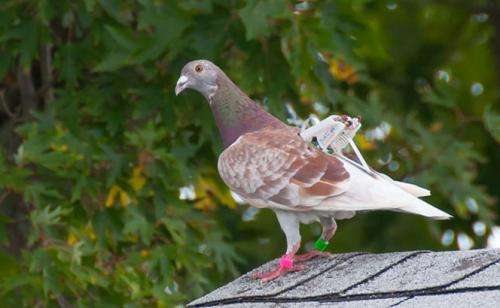Energy harvesting takes wing in merger of engineering and biology

A bird flapping its wings or a fish's deep dive may be pictures of nature in action, but in their elegant simplicity Michael Shafer sees the complex challenges of merging technology with a biological system.
As an engineer interested in energy harvesting, Shafer also knows that animal movement offers opportunity, at least on a limited scale. While solar panel arrays and towering windmills generate electricity from natural forces, a pod of dolphins with battery packs isn't going to light a city.
But the motion of animals could power small devices that allow biologists to collect information about behavior that eludes them under the limitations of current technology.
"I'm trying to take energy that's all around us—differences in temperature, mechanical energy, kinetic energy—and convert it into something useful," said Shafer, assistant professor of mechanical engineering at Northern Arizona University.
As a Ph.D. student at Cornell, Shafer helped bring that vision into reality by developing what is essentially a bird backpack: an ultra-light device that generates power through the flapping of a bird's wings. A piezoelectric material—one that produces electricity when pressure is applied—lies at the heart of the device, which recently caught the attention of Popular Science.
Today, having returned to his undergraduate alma mater, Shafer is investigating ideas beyond birds, such as terrestrial and marine applications. But he continues to apply the lessons he has learned, including his use of a systems approach to solve engineering problems and establishing a two-way channel of communication with biologists.
"If I were going to design an energy harvester for a building system, or a static remote sensor on a bridge, that can be challenging," Shafer said. "But it's much harder to take that system and apply it to an animal."
In the case of birds, the biggest limitation was the small amount of weight they can carry. Most weigh less than 100 grams and can carry only about four percent of their own mass.
"If I have a bird flapping at a certain frequency that can carry only so much mass, I have to ask how I can design something to maximize power given those conditions," Shafer said. "There isn't much margin for error."
Shafer points to a "confluence of technologies" that is making energy harvesting more accessible. The field is not new, with research having been conducted on solar, piezoelectric, kinetic, electromagnetic, thermoelectric and other processes. But progress is occurring rapidly.
"What has really created viability for the technology and really spurred people to investigate energy harvesting is a precipitous decline in the power consumption of microelectronics," Shafer said. "Now low energy sources are suddenly starting to become viable as a method of powering electronics."
Yet as technological advances make smaller devices possible, Shafer must always consider "second order" effects, such as not creating too much drag on an animal and fabricating a device that biologists can handle easily.
"Animals don't have a great way of putting on an engineering system," Shafer said. "Form factor is a big driver—the system has to fit the animal. That's really where you start going to the biologists, and there's a lot of back and forth."
Provided by Northern Arizona University



















